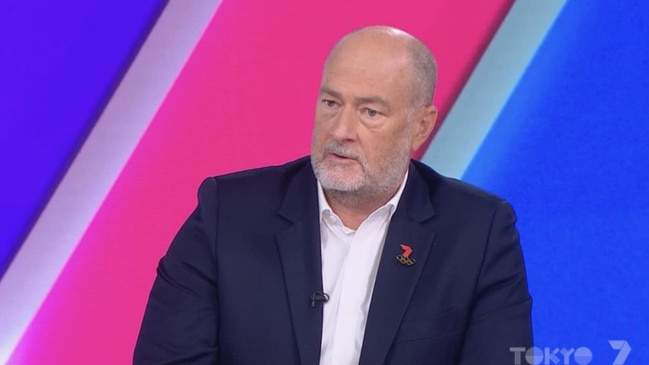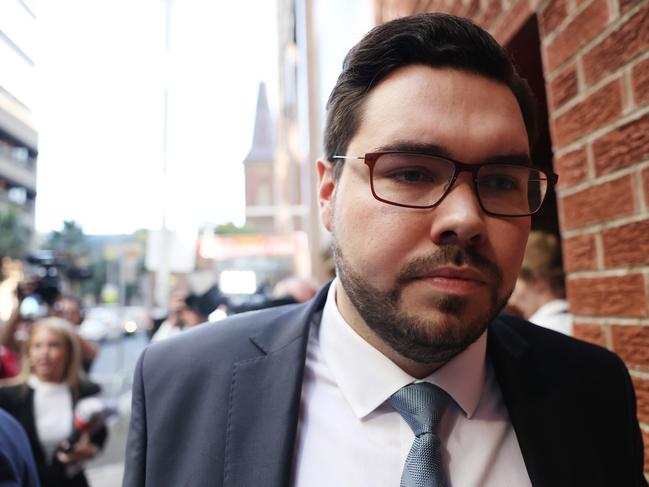‘Massacre’: Australian television’s ‘darkest day’ points to an industry in total chaos
Australian television is in the grips of chaos as top-rating Seven wages a “bloodbath” at its most senior levels, while its rival lurches from scandal to scandal.

NSW
Don't miss out on the headlines from NSW. Followed categories will be added to My News.
A “massacre” within the senior executive ranks of Channel 7 has shocked industry watchers, who say it’s a sign of just how serious the crisis is at the network – and in television broadly.
Seven West Media chairman Kerry Stokes, the billionaire media magnate who owns a controlling share of the network, oversaw a brutal clearing out of his nine-person management team on Tuesday.
Industry veteran Kurt Burnette, who was the chief revenue officer, Melissa Hopkins, chief marketing and audience officer, and Lewis Martin, head of network sport and Melbourne managing director, were all sent packing.
Prominent industry commentator Tim Burrowes, publisher of the Unmade newsletter, described it as “one of the most dramatic days the media market has seen”.
“Factor in the departure of CEO James Warburton, legal chief Bruce McWilliam and news chief Craig McPherson in April, and the leadership of Australia’s most watched TV network has changed almost entirely in just two months,” Burrowes pointed out.
“Among Australia’s big media companies, that’s unprecedented.”



The company described it as a necessary part of a massive restructure, while Burrowes called it a “massacre”.
“It’s got an end-of-days feel about it,” Anna Potter, a professor in digital media and cultural studies at Queensland University of Technology’s School of Communications, agreed.
“Commercial broadcasting is being savagely impacted by the loss of advertising revenue to new and more efficient platforms. And of course, the Meta deal has fallen over, which has put further pressure on them.”

Shock decisions like the executive level bloodbath are to be expected when companies are in crisis, she said.
“This is what happens when you put businesses that have enjoyed market dominance for decades under immense financial pressure,” Prof Potter said.
Industry at crisis point
Australia’s three commercial networks have battled against an unstoppable tide of declining viewership numbers and dwindling advertising revenue for the better part of two decades.
Marc C-Scott, a senior lecturer in screen media at Victoria University, said commercial broadcasters had been too slow to innovate in response to the rise of the internet and streaming.
“It’s not like any of this has come out of nowhere,” Dr C-Scott said.
“They’ve had years to change their approach, and it’s been limited. I wouldn’t say that they haven’t done it at all, but they’ve very much wanted to hold on to the elements that were making them money.
“And unfortunately, they held on too long. They probably haven’t looked at the things in the rear-vision mirror that they needed to.
“Streaming obviously being one part of that, but also the impact from streaming services and ad market shifts more broadly.”

Heavy losses have quickened over the past several years.
“I think it’s fair to say that commercial television is at crisis point,” Prof Potter said.
“Much of the ad revenue has fallen and the market has fragmented, just as audiences have fragmented, across new digital platforms.
“At the same time, broadcasters’ costs are actually increasing because they have more platforms to program. Content costs are up but the revenue is down.
“For all three of them, it’s a crisis. And I think the question of whether the Australian market can sustainably continue to support three broadcasters is more relevant than ever.”
Scandals across the board
Seven’s senior job losses and a major restructure come hot on the heels of a messy and damaging period for Seven and its lauded news division.
Damaging details about how marquee current affairs show Spotlighthandled its exclusive interview with rapist Bruce Lehrmann created a storm, with revelations the network picked up the tab for cocaine and sex workers.

There were also reports of high-level attempts to kill a journalist’s story about an internal probe of spending at flagship breakfast show Sunrise.
And then, the morning after the horror Westfield Bondi Junction attack, Seven’s news outfit misidentified the killer as a young Sydney university student, who quickly lawyered up.
A series of senior departures quickly followed those scandals.
“If a TV network puts a roof over a rapist’s head, employs a war criminal (Ben Roberts-Smith) and pays a creep, it might just have a cultural problem,” Burrowes said.


Seven’s main rival, the Nine Network, provided a brief and welcome distraction when its own disturbing cultural issues blew wide open this month.
Serious allegations of misconduct against Darren Wick, the veteran director of news, were made prior to his abrupt departure, which came with a generous golden parachute.
An independent external review of systemic cultural issues has been flooded with complaints, according to The Australian, including anger over what many women see as “the cover-ups, lying to staff and the gushy emails about Wickie” from management.

Two senior male managers, who remain employed at Nine, have also been reported to the review over allegations of sexual harassment and bullying.
It was also revealed Adrian Foo, the head of communications for Nine’s streaming platform Stan, abruptly quit his post after an investigation commenced into allegations of inappropriate conduct.
He too received a generous severance package.

And then to cap it off, Nine’s chairman and former Liberal treasurer Peter Costello was filmed in an ugly physical altercation with a journalist at Canberra Airport.
He stepped down days later.
“Commercial broadcasting in Australia has a very distinctive management and leadership culture, which has, from where I’m sitting, always looked dated and toxic,” Prof Potter said.
“People tolerated or at least ignored that kind of behaviour when these networks were making a lot of money,” Prof Potter said.
“They were giants in the 1980s and 1990s, and into the early 2000s. They were so powerful that Seven and Nine could virtually do whatever they wanted.
“Those days are over. Accountability is here. And it’s proving to be pretty messy for all involved.”

Not to be left out, Network Ten is also in the doldrums thanks to its worsening performance in the ratings, sparking the cancellation of top ticket franchises.
Damning claims about an apparent attempt within the company, at senior levels, to white-ant star broadcaster Lisa Wilkinson also emerged in April.
That’s despite Wilkinson still being on Ten’s payroll.
And there remain swirling questions over the network’s future ownership, with US parent company Paramount in stalled merger talks.
“There are many factors impacting television broadcasters right now and raises questions about how they fight in this media landscape,” Dr C-Scott said.
“It’s going to be a tricky time over the next couple of years, I think.”
Originally published as ‘Massacre’: Australian television’s ‘darkest day’ points to an industry in total chaos





